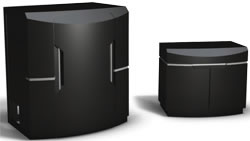Superresolution Microscopy
 Applied Precision OMX V4 Blaze 3D-SIM Super-resolution microscope (K06 020)
Applied Precision OMX V4 Blaze 3D-SIM Super-resolution microscope (K06 020)
The core facility holds an OMX V4 Blaze 3D-SIM Super-resolution microscope from Applied Precision. 3D-SIM is a super-resolution technique that uses structured light patterns to achieve sub-diffraction limit imaging. The structured light pattern creates interference moiré patterns with the fine structures of the sample which are captured in the resulting fluorescence images. The sample is imaged using several different orientations and phases of the light pattern then computer algorithms process the data set and generate the final super-resolution image.
The OMX V4 can be used in both a structured illumination (SI) and a Conventional mode. The SI mode is used for super-resolution, whereas the conventional mode is used for fast (up to 40-60 frames per second) imaging. The resolution that can be obtained with 3D-SIM is 90 nm laterally (xy) and 220 nm axially (z). In comparison, with conventional widefield microscopy, the resolution would be 320 nm in xy and 540 nm in z, and after deconvolution 250/430 nm.
Gallery:
 |
 |
 |
 |
 |
 |
 |
